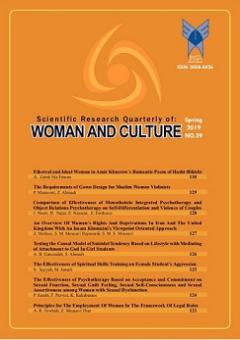The Requirements of Gown Design for Muslim Women Violinists
Subject Areas : Art and Architecture
Pariya Manzoori
1
,
Zahra Ahmadi
2
![]()
1 - Art University in Tehran, Department of Graduated in cloth design, Tehran, Iran.
2 - Art University in Tehran, Department of Carpet, Tehran, Iran.
Keywords: women violinists, Muslim women gown, gown design,
Abstract :
The purpose of this study was therefore to identify: a)Iran's mandatory regulations for female violinists’ dress; b) the selection criteria for violinists' gown; and finally, c) the extent to which the gown, designed to that effect, being accepted by female violinists and the audience. Then this research and design endeavor aim at reaching the requirements of gown design for Muslimwomen violinists. Due to delicate or latent requirements, the design or procurement of occupational cloth -i.e. gown for female violinists- has always been one of the most challenging assignments for designers and textile experts. Following the administration of a survey questionnaire, using 55 female violinists who were selected in purposeful sampling method and a semi-structured interview session was also managed with inviting 15 of them. A descriptive-analytic method was used to analyze the data. Based on the created insights, design criteria were developed and fabrication constraints were considered. Concepts were developed by the lead author and later presented to the violinists and a group of invited people as audience. The results provided full support for aims of the research. It was showed that women violinist has considered the exact criteria such as visual differentiation, formality and comfort of clothing.
- افرا، بابک، امیدوار، امیر. (1393). ارزیابی اثرات ذخیره حرارت و رطوبت در لباس و اصلاح مدل گایج برای پیشبینی احساس حرارتی و پاسخهای فیزیولوژیکی بدن. مجله مهندسی مکانیک مدرس، 3(14): 167-175.
- آسایش، پریسا، فرخ سرشت، مهین، خجسته، محمد رضا. (1390). ﻃﺮاﺣﯽ ﻟﺒﺎس ﺑﺎﻧﻮان دوﭼﺮﺧﻪ ﺳﻮار ﻣﺴﻠﻤﺎن (رﺷﺘﻪ ﭘﯿﺴﺖ). سومین کنفرانس ملی مهندسی نساجی و پوشاک، یزد، 1 -13 .
- حجازی زاده، زهرا، ﻛﺮﺑﻼﺋﻲ درﺋﻲ، علیرضا. (1394). آﺳﺎﻳﺶﺣﺮارﺗﻲ در اﻳﺮان. ﺟﻐﺮاﻓﻴﺎ، ﻓﺼﻠﻨﺎﻣﻪﻋﻠﻤﻲ ـ ﭘﮋوﻫﺸﻲ و ﺑﻴﻦ اﻟﻤﻠﻠﻲ اﻧﺠﻤﻦﺟﻐﺮاﻓﻴﺎی اﻳﺮان، ﺷﻤﺎره۴۶، پاییز 1394، 21 – 39.
- عاصی حداد، سمیرا، شاکری، ملیحه، احمدی، محمد صالح. (1394). طراحی و تولید لباسکار برای کارگران زن کارخانههای پوشاﮎ. مجله علوم و فناوری نساجی، شماره 3، 3 – 8.
- نصیری، پروین.، منظم، محمد رضا. ،گلبابایی، فریده، شمسی پور، علی، عربعلی، بیک حسین، عباسی نیا، مرضیه، و همکاران. (1396). ریسک فاکتورهای فردی در مواجه با استرس حرارتی محیط کار. بهداشت و ایمنی کار، 7(2): 163-176.
- نیازخانی، الهه. (1390). مقاومت در برابر نفوذ بخارآب پارچههای کشباف در شرایط گوناگون. نساجی امروز، 115: 59–61.
- Anand, S. (2003). Sportswear Fabrics. Knitting International, 23-25.
- Bohn, C. (2004). Clothing as Medium of Communication, University of Lucerne. Department of Sociology.
- Botha, M. E. (2014). Exploring the meaning of concert dress in female vocal performance: phenomenological study. MMus Degree, Department of Music, university Pretoria.
- Cardello A.V., & Schutz, H. G. (2005). Relationship Between Perceived Clothing Comfort and Exam Performance. Family and consumer science research journal, 31: 1 - 31.
- Choi, M-S., & Ashdown, S. P. (2002). The design and testing of work clothing for female pear farmers. Clothing and Textiles Research Journal, 20(4): 253-263.
- Griffiths, N. K. (2008). The effects of concert dress and physical appearance on perceptions of female solo performers. Musicae Scientiae, 5: 273-290.
- Griffiths, N. K. (2009). Posh music should equal posh dress’: An investigation into the concert dress and physical appearance of female soloists. Psychology of Music, 38(2): 159–177.
- Griffiths, N. K. (2011). The fabric of performance: values and social practices of classical music expressed through concert dress choice. Music Performance Research, Royal Northern College of Music, 4: 30-48.
- Gupta, D., Chattopadhyay R., & Bera, M. (2011). Comfort properties of pressure garments in extended state. IJFTR, 36(4): 415-421.
- Hatch, K. L. (1993). Textile science. West Publishing Co, Minneapolis, Paul, MN, 6, 26, 266.
- Havenith, G., Holmer, I., & Parsons, K. (2002). Personal factors in thermal comfort assessment: clothing properties and metabolic heat production. Energ Buildings, 34(6): 581-591.
- Horridge, P., & Richards, L. (1984). Relationship of fashion awareness and clothing economic practices. J. Home. Econ. Res., 13: 138–152.
- Kamalha, E., Zeng, Y.C., Mwasiagi, J.I., & Kyatuheire, S. (2013). The comfort dimension; a review of perception in clothing. J. Sens. Stud., 6: 423-444.
- Leder, J., Lulić, T.J. & Sušić, A. (2010). Ergonomic aspect of violin playing. 4th International Ergonomics Conference,
- Lee, H.S., Park, H.Y., Yoon, J.O., Kim, J.S., Chun, J.M., Aminata, I.W., Cho, W.J., & Jeon, I.H. (2013), Musicians'Medicine, Musculoskeletal problems in string players. Clinics in Orthopedic Surgery, 5(3): 155-160.
- Medoff, E. (1999). The Importance of Movement Education in the Training of Young Violinists. Medical Problems of Performing Artists, 14(4): 210-219.
- Moody W., & Sinha, P. (2010). An Exploratory Study: Relationship between Trying on Clothing, Mood, Emotion, Personality and Clothing Preference. J. of Fashion Marketing and Management, 14(1): 161-179.
- Pontrelli, G.J. (1977). Partial Analysis of comfort’s Gestalt, in Clothing Comfort, eds N.R.S. Hollies and R.F. Goldman, Ann Arbor Science Publishers Inc. Michigan, USA, 1 – 80.
- Roos, J. W. (2005), Violin playing: teaching freedom of movement. MMus dissertation, University of Pretoria.
- Rubenstein, R. P. (2001). Dress Codes: Meanings and Messages in American Culture. (2nd Ed.). Oxford: Westview Press.
- Slater, K. (1985). Human comfort. Vol. 2, Charles C. Thomas Publisher, Springfield IL, USA.
- Trevo, C., & David, H. (2016). Animated performance: ‘Better’ music means larger movements, Music. Ohio State University, Columbus, U.S.A., ICMPC14, July 5–9 San Francisco, USA. 420 -423.
- Upreti, M., & Gahlot, M. (2016). Subjective Testing for Clothing Comfort. Int. J. Emerging Res. In Management & Technology, 5(4): 20-38.
_||_

